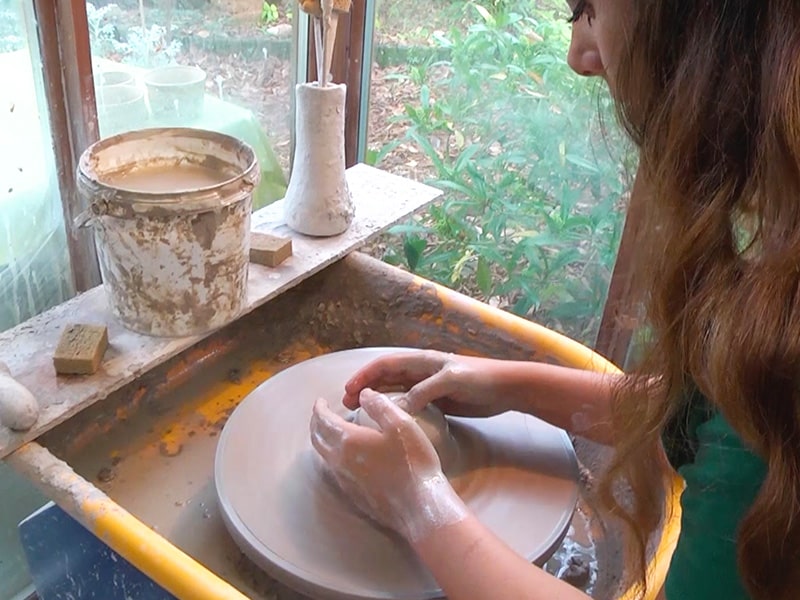
What is advanced ceramics?
Advanced ceramics are also known as technical ceramics or fine ceramics. In Asia, advanced ceramics are generally referred to as industrial ceramics.
Advanced ceramics is quite different from pottery and porcelain, such as ceramic tableware, sanitaryware, ceramic sanitation, wall and floor tiles for construction. Generally, pottery and porcelain are called traditional ceramics.
Advanced ceramics is an inorganic and solid material that is a non-metallic element combined by ionic bonds with covalent bonds.
The powder composition is strictly controlled in the manufacturing process, the forming process, the sintering system and the precision machining process chosen to make materials with perfect physical characteristics.
With better physical performance compared to other materials, advanced ceramics are widely used in areas such as semiconductors, automobiles and industrial machinery.
Advanced ceramic type
Today, there is a wide range of advanced ceramics:
Alumina (Al2O3)
Alumina ceramics is the most widely used advanced ceramic material. It offers superior mechanical strength, electrical insulation, high frequency retention, thermal conductivity, heat resistance and corrosion resistance. Sapphire is a monocrystalline form of alumina.
Zirconia (ZrO2)
Zirconia ceramics is the strongest and hardest material among advanced ceramics. It is used to create special blades for high-performance scissors, knives and precision beads, once considered impossible applications.
Steatite (MgO – SiO2)
Steatite is a magnesium silicate material with high electrical resistance at high temperatures, good mechanical strength and a very low dielectric loss factor, which has been used for many decades as insulators or housings for electrical components.
In addition, steatite ceramic is an excellent material for electrical engineering, as it can be easily sintered into a wide variety of shapes, such as washers, rings, resistance shapes, gaps and beads.
Silicon Carbon (SiC)
This artificial compound is synthesized from silica sand and carbon. It offers the best combination of heat resistance, light weight and corrosion resistance, and maintains its resistance to high temperatures (1500 ℃).
Silicon nitride (Si2N4)
Among advanced ceramics, this lightweight, corrosion-resistant material offers the highest level of toughness and resistance to high-temperature thermal shock, making it ideal for use in engine components.
Characteristics of advanced ceramics
Electrical Properties
- Electrical insulation
Advanced ceramics are insulating materials that do not conduct electricity.
- Dielectricity
Advanced ceramics has become an indispensable material for the production of capacitors and electronic components widely used in products such as computers, televisions and cell phones.

Capacitors act as “traffic controllers” in an electronic circuit by routing electricity to certain parts, temporarily blocking electricity or blocking only certain types of electrical signals.
- Conductivity
Although advanced ceramics are generally insulating materials that block electricity, semiconducting ceramics can be created to conduct electricity depending on their temperature and the level of voltage applied.
Physical properties
- hardness
The signature feature of advanced ceramics is their extreme hardness; therefore, they have a valuable use in high-performance applications.
The hardness of alumina ceramics is almost 3 times that of stainless steel. This extreme hardness is one of the many unique properties that make advanced ceramics “super materials” for modern technology.
- Stiffness
Advanced ceramics have high stiffness, which is measured by inspecting the elasticity of a specimen after a load is applied.
Materials that exhibit less elastic deformation under load have higher levels of stiffness.
- Fracture Resistance
Fracture toughness measures the fracture resistance of a cracked material.
Although advanced ceramics generally have low fracture toughness, partially stabilized zirconia, used for products such as scissors and knives, offers significant improvements in fracture toughness.
- Specific gravity (density)
Advanced ceramics have a lower density (specific gravity) than high-strength metals. In the same volume, many advanced ceramic materials weigh only half the metal.
Chemical properties
Advanced ceramics have high levels of chemical stability. As a result, advanced ceramic materials are highly resistant to chemical corrosion.
Chemicals – including hydrochloric acid, sulfuric acid, nitric acid, sodium hydroxide and hydrofluoric acid. The results were analyzed and materials dissolved in relatively large quantities were found to be more sensitive to chemicals.
Thermal properties
- Resistance to heat
Conventional ceramics, including bricks and tiles, are well known for their ability to withstand high temperatures. Alumina ceramics begin to melt or decompose at temperatures above 1800 ℃, much higher than the melting point of metallic materials.
- Thermal expansion
Low thermal expansion
When materials are heated, their size and volume increase in small increments, in a phenomenon known as thermal expansion. The coefficient of thermal expansion indicates the expansion of a material by an increase in temperature of 1 ℃. Different materials have different thermal expansion. Advanced ceramics have low coefficients of thermal expansion – less than half those of stainless steels.
- Thermal conductivity
The property of heat transmitted by a material is called thermal conductivity.
Advanced ceramics offer a wide range of thermal conductivity.
Among advanced ceramics, some materials have high levels of conductivity and transmit heat well, while others have low levels of conductivity and transmit less heat.
Silicon carbide transfers heat particularly well while zirconia ceramics effectively block heat and the coefficient of thermal conductivity is low – about 1/10 of that of stainless steel.
Advanced ceramic production process
Milling and mixing of raw materials, spraying and drying
The raw materials used in the manufacture of advanced ceramics (also called “fine ceramics”) include inorganic solid powders with precisely controlled purity, size and distribution. These raw materials are formulated for specific properties and functionalities and then mixed with a binder or a binder.
Shaping
Typical processing method:
Dry Pressing, Injection and Casting, HIP, CIP
Firing (sintering)
The shaped green body is fired at extreme heat in temperature-controlled ovens.
The firing removes moisture and binders. With an additional firing, the powder particles are sintered together and the products shrink due to reduced porosity. This process results in products of extreme density and hardness.
Advanced Ceramic Applications
Advanced ceramics is a new material for a wide range of applications.
- Advanced ceramics products offer the perfect solution and an economical and high-performance alternative to traditional materials such as metals, plastics and glass.
- Advanced ceramic materials can be processed into different components for different industries, such as
- Electrical components (support material, mounting brackets, insulators and resistors);
- Rotors, combustion chambers, ceramic brake and exhaust;
- Laser positioning mirrors and packaging;
- Protection unit (ceramic armor and bulletproof card);
- Furnace radiant heaters;
- Hot gas filtration
- Fuel cell membranes;
- Diesel engine filters and fuel injector parts;
- Textile and yarn guides;
- Abrasion coatings;
- Grinding media.
